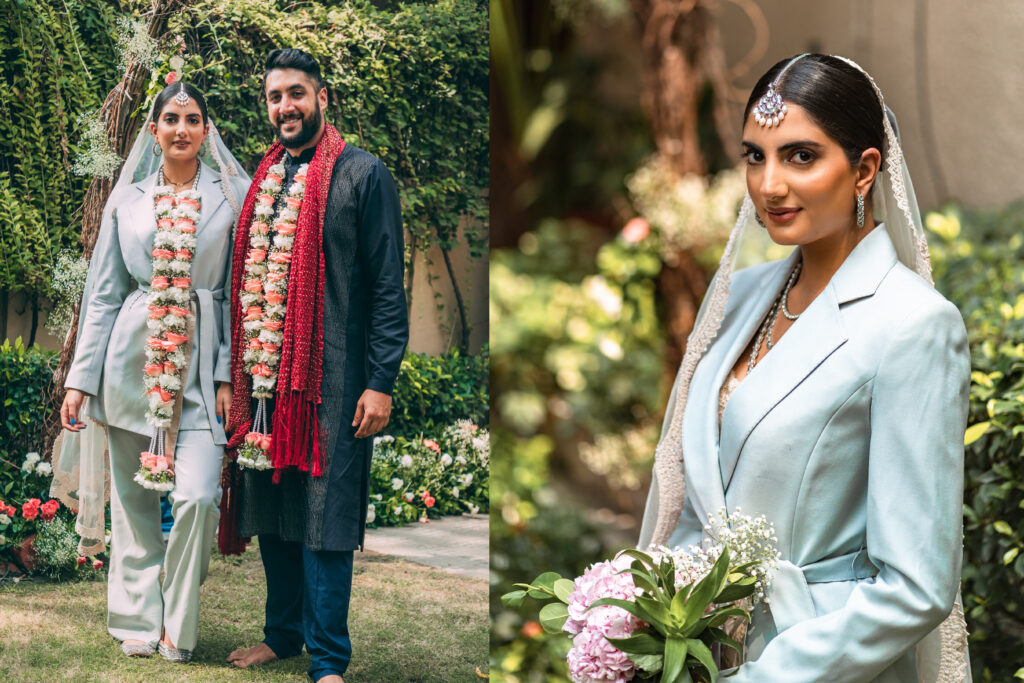
[Photos Courtesy: Saumya Gupta]
I believe that the pantsuit is the sartorial equivalent of a power move – confident, effortless, and statement-making. It accentuates a structured figure whilst providing a modest approach to formal wear. It has been favored by influential women throughout history (see Michelle Obama during the Becoming book tour) after a controversial beginning of being considered too bold, masculine, and inappropriate for women. The essence of the two-piece garment lies in the radical rejection of traditional gender-assigned clothing and heteronormative style. No longer is a suit limited to gender, class, or a binary of “men or women.”
View this post on Instagram
In recent years, we have seen monochrome suits dominate runway and streets alike. Now, unsurprisingly, suits are paving their way into the world of bridal attire. Brides are inclined towards a pantsuit for their versatile nature: a blank canvas. One can embellish, accessorize, and decorate the top and bottom, whilst adding contrast with a bustier below. By extension, pantsuits are receiving a “desi makeover” from being tailored using sari fabric to being paired with classic jhumkas. Stylist Sandy Gill (@thesandylion) spearheaded the “sari suit” look on social media, naming her unique custom creations ‘The Sandy Suit’. Gill’s suits are loved (and flaunted) by a host of celebrity clients, including Beena Patel Minhaj, Nabela Noor, Lilly Singh, and Utkarsh Ambudkar.
[Read Related: 5 Must-Try West-Meets-East South Asian Bridal Looks]
Recently, Insider featured entrepreneur Sanjana Rishi who chose a pre-owned Gianfranco Ferré baby-blue pantsuit for her big day. It was simultaneously something blue, something old, and fairly new to the bridal- fashion world. Rishi combined the elegant pantsuit with a beautiful white sheer dupatta, maang teeka, and hooped earrings. This was a bridal outfit that truly expressed the bride, and her commitment to “supporting sustainability, local artisans, and ethical shopping.”
View this post on Instagram
Rishi’s look is proof that a commitment to sustainable fashion can be woven into the fabric (literally) of all parts of the consumer’s life: workwear to wedding wear. In the greater dialogue of environmentalism, terms such as “ethical,” “sustainable,” and “eco-friendly” seem to get verbally thrown around, with big brands capitalizing on the ambiguous definitions of the terms themselves. This has amounted to the growing issue of greenwashing, a term coined in the 1980s, to explain when a brand’s marketing around sustainability runs counter to its actual business practice. There is thus a growing concern that one’s fashion choices could contradict one’s environmental efforts.
Sustainability, and what it means in the bridal wear sphere, is a conversation that is becoming more and more prevalent in recent years. We have seen the growth of brands such as Anita Dongre who promote sustainability as the very ethos of their brand. The rise of purchasing ‘pre-loved’ clothes, either from thrift or consignment stores, is a way to practice “conscious shopping” at the very root of purchasing. Alongside this, there must be work done to remove the stigma surrounding “pre-loved” clothes as less than brand new clothes. I believe there should be a push from all levels of the industry (consumers, influencers, and fashion houses) to normalize wearing the same outfit more than once – which, at first, seems like a trivial or irrelevant issue, but largely impacts the consumption behavior of fast fashion.
View this post on Instagram
Bridal wear should also never compromise style for tradition – when there is a way to pull off both. Bridal wear can’t be put in a box – it is about interpretation, adaptation, reinvention, and most important of all, something that reflects the bride’s individuality and unique sense of style. We are now seeing more and more brides diversifying the South Asian bridal fashion model of red saris and lavish gold jewelry. For example, the brand JADE by MK featured offbeat, subdued tones for their bridal designs for those who want an “unconventional yet unforgettable color palette.”
There is a way to express one’s true self within clothes, whether that be a modern pantsuit or a traditional lehenga. Clothes should be an extension of one’s character, belief, and individuality — bridal wear has become a celebration of all three. Modern desi brides are defying tradition by diversifying, improvising, adapting upon it. And we love witnessing this revolution!




